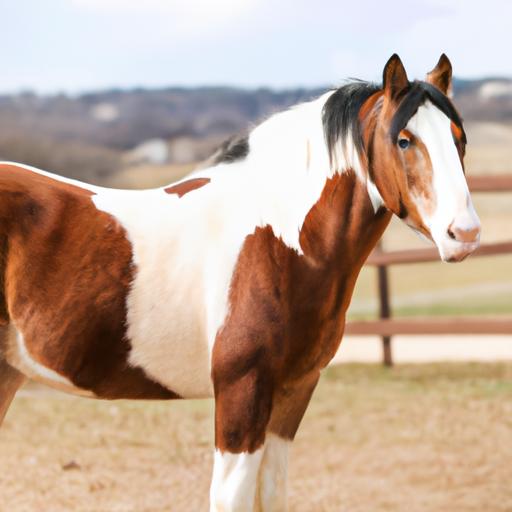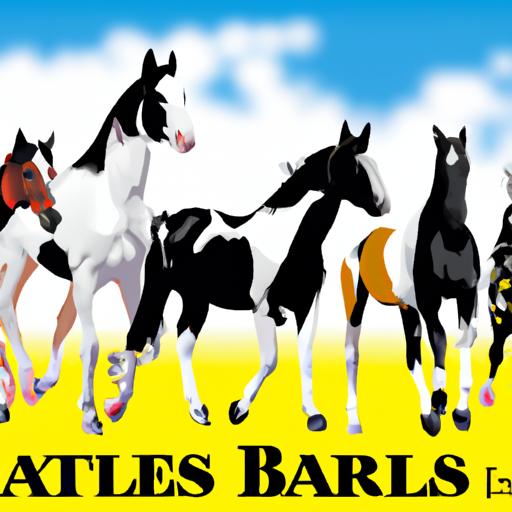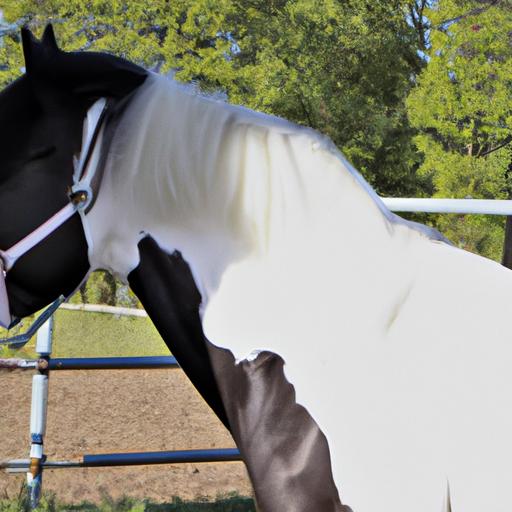Uncover the beauty and versatility of horse breeds paint. Explore their captivating coat patterns and discover the perfect paint horse for your riding goals.
When we think of horses, our minds conjure up images of magnificent creatures galloping across vast fields, their manes flowing in the wind. Horses have captivated our hearts for centuries, serving as loyal companions, reliable work partners, and awe-inspiring athletes. But within the realm of horse breeds, there exists a group that stands out with its unique and captivating beauty – the paint horse breeds.
What makes paint horse breeds so special? These horses, known for their stunning coat patterns, hold a significant place in the equine world. Their captivating appearances coupled with their versatile capabilities make them a popular choice among equestrians and enthusiasts alike.
So, what exactly are paint horse breeds? Paint horse breeds are a specific category of horses that exhibit distinctive coat patterns, characterized by patches of white and another color, such as black, bay, or chestnut. These patterns can be in the form of splashes, spots, or even a solid-colored base with patches.
The importance of paint horse breeds lies not only in their striking appearance but also in their versatility. These horses excel in various disciplines, including pleasure riding, ranch work, rodeo events, and even competitive sports such as dressage and jumping. Their adaptability and willingness to work make them ideal partners for riders of all levels, whether you’re a beginner looking for a gentle companion or an experienced rider seeking a competitive edge.
As we embark on this journey through the world of paint horse breeds, we will delve into their fascinating history, explore the characteristics that set them apart, and provide insights on choosing the perfect paint horse breed that suits your riding goals and preferences. So saddle up and join me as we uncover the wonders of horse breeds paint!
Stay tuned for the next section, where we will dive into the characteristics that make paint horse breeds truly unique.
Characteristics of Paint Horse Breeds

Physical Attributes and Unique Coat Patterns
Paint horse breeds are renowned for their striking and diverse coat patterns that make them instantly recognizable. These captivating patterns come in a variety of forms, including Overo, Tobiano, Tovero, and Sabino. Each pattern has its own distinct features and arrangement of color patches, adding to the allure of these magnificent creatures.
Overo paint horses typically have a base color that is solid or minimally marked, with irregular, scattered white patches. These patches often appear jagged or disconnected, giving the horse a captivating and eye-catching appearance.
Tobiano paint horses, on the other hand, have a solid-colored head and typically display large, rounded patches of color on their bodies. These patches tend to cross over the horse’s back and often extend downward from the top line.
Tovero paint horses exhibit characteristics of both Overo and Tobiano patterns. They often have a dark-colored head with white markings, and their color patches are a combination of the two patterns, resulting in a harmonious blend of colors.
Sabino paint horses possess unique white markings that can appear on their faces, legs, and bodies. These markings often give the impression of “roaning” or a speckled appearance, adding an extra touch of elegance to their overall appearance.
Apart from their captivating coat patterns, paint horse breeds boast a range of physical attributes that contribute to their beauty and athleticism. They typically have strong, muscular bodies with well-rounded hindquarters, allowing for powerful bursts of speed and agility. Their expressive eyes and refined facial features further enhance their appeal, drawing attention and admiration wherever they go.
Behavioral Traits and Temperament
In addition to their physical attributes, paint horse breeds are known for their amiable and gentle nature. They often possess a calm and even-tempered disposition, making them suitable for riders of all ages and skill levels. Whether you’re a novice rider or a seasoned equestrian, paint horses can provide a reliable and trustworthy partnership.
Their willingness to please and their intelligence make them highly trainable. They are quick to learn and adapt, making them ideal for various equestrian disciplines. Paint horses have a natural curiosity and a strong desire to bond with their human counterparts, fostering a deep sense of connection and mutual understanding.
Additionally, paint horses are renowned for their versatility. They excel in a wide range of activities, including pleasure riding, trail riding, ranch work, and competitive events. Their agility, athleticism, and willingness to work make them excellent performers in disciplines such as Western riding, English riding, and even in the show ring.
In the next section, we will embark on an exciting journey into the history and origins of paint horse breeds, uncovering the roots of these magnificent creatures.
History and Origins of Paint Horse Breeds

Tracing the Origins of Paint Horse Breeds
The history of paint horse breeds is as intriguing as their captivating coat patterns. To understand their origins, we must delve into the rich tapestry of equine history. Paint horse breeds have roots that can be traced back to ancient times, where their distinctive coat patterns were highly admired.
Did you know that the ancestors of paint horses can be found in ancient cave paintings? These ancient depictions of horses with patchy coats provide evidence of the long-standing existence of horses with unique colorations. Throughout history, these horses were highly valued for their striking appearance and often reserved for nobility and high-ranking individuals.
Historical Significance and Evolution of Paint Horse Breeding
As civilization progressed, paint horse breeding evolved, with various cultures contributing to the development of this breed. Native American tribes in North America played a significant role in the history of paint horses. They selectively bred horses with desirable coat patterns, resulting in the creation of the famous “war paint” horses.
The arrival of the Spanish conquistadors in the Americas had a profound impact on the evolution of paint horse breeds. The introduction of the Spanish horses, known as “Pintos,” further influenced the development of the breed. These Pintos possessed the distinct tobiano pattern, characterized by large, rounded patches of color over a white base.
Over time, as settlers moved westward and engaged in horse trading, the paint horse breed continued to flourish. In the mid-20th century, the formation of the American Paint Horse Association (APHA) solidified the breed’s recognition and preservation efforts. Today, the APHA serves as a governing body, promoting the breed’s integrity, maintaining breed standards, and organizing competitions and events.
The history and evolution of paint horse breeding reflect the deep connection between humans and horses, as well as the appreciation for their unique and enchanting appearances. It is through the preservation of their history that we can continue to honor and celebrate these remarkable equine companions.
In the next section, we will explore some of the popular paint horse breeds, each with its own distinct characteristics and specialties.
Popular Paint Horse Breeds

When it comes to paint horse breeds, there are several notable ones that have gained recognition for their distinct features and exceptional abilities. Let’s take a closer look at two well-known paint horse breeds: the American Paint Horse and the Pinto Horse.
American Paint Horse
The American Paint Horse, often referred to simply as the Paint Horse, is a breed renowned for its striking coat patterns and versatility. With its roots tracing back to the United States, this breed has captured the hearts of many equestrians around the world.
Distinct Features: What sets the American Paint Horse apart is its unique coat patterns, which can range from Overo to Tobiano and Tovero. Overo patterns typically display irregular markings, with color appearing in horizontal patterns across the horse’s body. Tobiano patterns, on the other hand, exhibit vertical white markings with well-defined edges. Tovero combines characteristics of both Overo and Tobiano patterns.
Specialties: American Paint Horses excel in a variety of disciplines, including western pleasure, cutting, reining, and trail riding. Their athletic ability, combined with their gentle temperament, makes them ideal for riders of all levels. Whether you’re looking to compete in the show ring or enjoy leisurely rides through scenic trails, the American Paint Horse can be your perfect partner.
Pinto Horse
The Pinto Horse is another popular breed that captivates with its coat patterns and charming personality. While not limited to a specific breed, horses with distinctive coat patterns falling under the Pinto category are considered Pinto Horses.
Distinct Features: Pinto Horses encompass a wide range of coat patterns, including tobiano, overo, and tovero. These horses often display a combination of large patches of solid color and white. Their patterns can be bold and eye-catching, making them a true delight to behold.
Specialties: Pinto Horses are celebrated for their versatility and are commonly seen in various disciplines, such as pleasure riding, driving, and even dressage. Their friendly and willing nature, coupled with their striking appearances, make them cherished companions for riders seeking a horse that stands out in the arena.
As you explore the world of paint horse breeds, keep in mind that these are just two examples of the many remarkable breeds within this category. Each breed brings its unique charm and capabilities, making it essential to consider your specific riding goals and preferences when choosing the perfect paint horse breed for you.
Stay tuned for the next section, where we will delve into the factors to consider when selecting a paint horse breed that aligns with your riding aspirations.
Choosing a Paint Horse Breed
When it comes to selecting a paint horse breed, it’s essential to consider various factors that align with your individual preferences and riding goals. Let’s explore the key considerations that can guide you towards finding the perfect paint horse companion.
Factors to Consider
1. Temperament and Personality: Every horse has its own temperament and personality traits. Some paint horse breeds are known for their calm and docile nature, making them suitable for beginners or riders seeking a relaxed riding experience. On the other hand, if you’re an experienced rider looking for a spirited and energetic partner, there are paint horse breeds that exhibit higher levels of energy and enthusiasm.
2. Riding Discipline: Determine the specific riding discipline you intend to pursue. Whether it’s trail riding, Western pleasure, jumping, or dressage, different paint horse breeds may excel in different disciplines. Research and identify the breeds that have a natural inclination towards your desired riding style, as this can greatly enhance your overall experience in the saddle.
3. Size and Conformation: Consider the size and conformation of the paint horse breed that suits your physique and riding preferences. Some riders may prefer taller and more robust horses, while others may feel more comfortable with smaller and compact builds. Assess your own comfort level and match it with the physical attributes of the horse breeds you’re considering.
4. Health and Maintenance: It’s crucial to be aware of any breed-specific health issues or maintenance requirements associated with the paint horse breeds you’re interested in. Regular veterinary care, grooming needs, and dietary considerations should be taken into account to ensure the well-being of your equine partner.
Matching Breed Characteristics to Individual Preferences and Riding Goals
By carefully evaluating the aforementioned factors, you can align the breed characteristics of paint horse breeds with your individual preferences and riding goals. Remember, each horse is unique, and it’s important to spend time interacting with potential horses to assess their compatibility with you.
Ultimately, the bond between you and your paint horse is a partnership built on trust, understanding, and shared goals. Selecting the right paint horse breed can significantly contribute to the joy and fulfillment you experience in your equestrian journey.
In the next section, we will conclude our exploration of horse breeds paint, summarizing the significance and appeal of these magnificent creatures.


